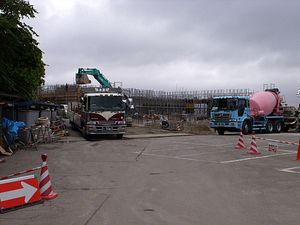Representatives of Prime Minister Shinzo Abe’s office recently reported plans to introduce legislation to bring in more overseas workers to bolster the shrinking labor force. The move is another indication of Japan’s concern over its demographic challenges. Its declining and rapidly aging population has fostered severe shortages in the labor force, particularly in such activities as construction. Further straining the labor supply in construction is the perception of job conditions described by the Japanese expression “3Ks”: kitanai, kiken, kitsui, respectively 汚い “dirty”, 危険 “dangerous”, きつい “demanding.” This has discouraged young Japanese from entering this industry and it estimated that in the second of half of the decade more than 25,000 construction workers will be required nationwide in Japan.
Unable to staff positions from the domestic labor force, many construction companies have turned to the foreign labor market to fill the gap, with the majority of migrant workers coming from China. While in principle, Japan does not accept low-skilled temporary workers, and the Immigration Control Law does not issue working visas to those who are involved in low-skilled work, Japanese firms have relied on the Technical Intern Training Program (TITP) to staff positions. The TITP allows foreign technical trainees or interns to “intern” at manufacturing, agriculture, or construction sites on a temporary basis. Under this program, foreigners are granted a three-year visa to undertake training and internships. The program has been criticized as simply as way to exploit foreigners as “slave labor”; nevertheless, many Japanese companies continue to take advantage of this system to import cheap labor from abroad.
The Rise of Foreign Seishain
One solution to address the labor shortage is the hiring of foreign labor in the form of Seishain, which can be literally translated as “regular employees.” A Seishain is guaranteed stable employment over the long term and the company is responsible for taking care of his or her monthly salary, bonus, and other benefits, which should cover health insurance, pension, and unemployment insurance. In return for job security, a worker hired with Seishain status generally has to bear more duties and responsibilities than employees hired in other forms, and often requires total commitment to the company in terms of time and loyalty.
While both Japan and foreign employees will benefit from this type of job arrangement, the opening of Japan’s door to foreigners in order to maintain continued economic growth will present major challenges. It is well known that the Japanese people are very proud of their perceived uniqueness and cultural homogeneity, and adhering to the past principles of pursuing cultural uniqueness creates a difficult situation for policymakers. The recognition of different norms and cultures will require drastic changes by Japanese society. Addressing this issue, however, will require Japan to commit to a policy of diversity and require the rights of employed immigrants be sufficiently protected and not exploited. There is no guarantee the Japanese government is well prepared to enact progressive policies for the acceptance of foreign employees.
Based on discussion with a number of Japanese construction managers and Chinese migrant workers currently employed in Japan, we found that one of the main difficulties faced by foreign employees is the pressure to assimilate into Japanese culture. This is a complex, if not impossible, task due to Japan’s monolingual and monocultural nature as well as the reluctance for Japan society to accept the diverse nature of foreigners.
Nevertheless, assimilation appears to be expected in all encounters with the Japanese and foreign employees have to endure criticism pertaining to any behavior which does not fit in with the “Japanese way.” While the workers in many respects are often treated as if they are Japanese, this hides that fact there is a lack of understanding and respect for diversity. Chinese workers, for example, are culturally and linguistically different and cannot be expected to completely assimilate into Japanese society.
Evidence also suggests there is a lack of trust in the foreign worker. Some general contractor companies even make it clear in their contracts that no foreign staff are allowed to be involved in specific activities at the construction site, as Japanese managers do not believe these workers can assure the same quality as Japanese.
Unfortunately, these prejudices against migrant workers negatively impact the work environment. Many Japanese employees worry that these individuals will eventually become their rivals at work. Japanese craftsmen, for example, prevent skilled migrant workers from being involved in professional assignments. This fear of job competition results in migrant workers being assigned low-level and unskilled tasks. The Chinese employees interviewed expressed frustration with this state of affairs and said they tend to lose interest in work after six months because they are anxious to learn more, but are not given the opportunity.
The migrant worker issue is one of the more challenging problems facing Japan today as policymakers look to find solutions to the social problems fostered by the low birthrate and lack of laborers in Japan. Changing long established societal norms and values will not come easy, but it is time for Japanese companies and society to reconsider issues related to migrant workers and reinforce laws and regulations that could help in dealing with cultural diversity in order to enable foreign workers to make a long-term contribution to the country.
Dr. Dennis McCornac is a Visiting Affiliate Professor at Loyola University Maryland. He has extensive experience in Asia previously holding university positions in both Japan and Vietnam.
Dr. Rong Zhang is an Associate Professor at Nishinippon Institute of Technology and has been teaching in Japan for over 15 years.

































